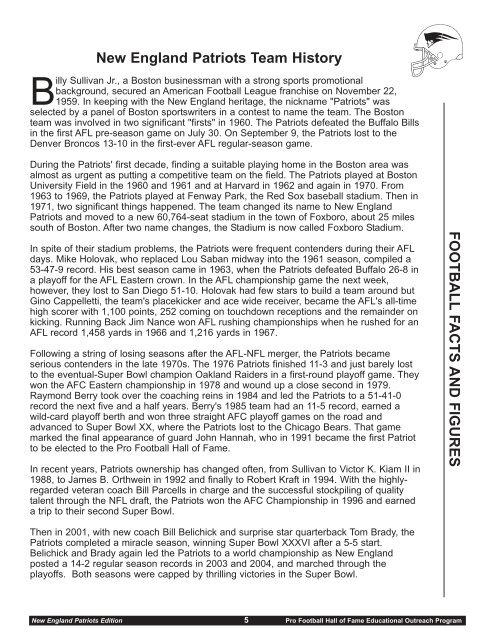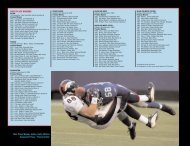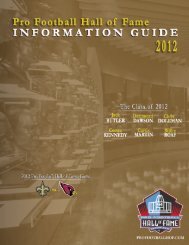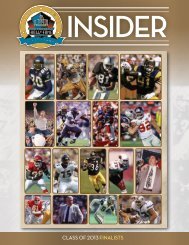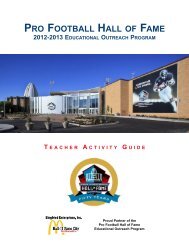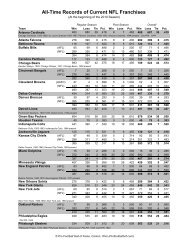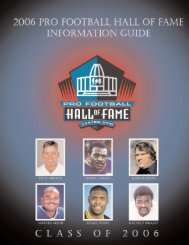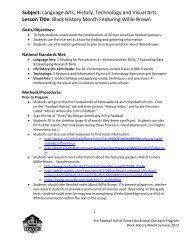Acknowledgements
New England Patriots Activity Guide.qxp - Pro Football Hall of Fame
New England Patriots Activity Guide.qxp - Pro Football Hall of Fame
- No tags were found...
Create successful ePaper yourself
Turn your PDF publications into a flip-book with our unique Google optimized e-Paper software.
New England Patriots Team HistoryBilly Sullivan Jr., a Boston businessman with a strong sports promotionalbackground, secured an American Football League franchise on November 22,1959. In keeping with the New England heritage, the nickname "Patriots" wasselected by a panel of Boston sportswriters in a contest to name the team. The Bostonteam was involved in two significant "firsts" in 1960. The Patriots defeated the Buffalo Billsin the first AFL pre-season game on July 30. On September 9, the Patriots lost to theDenver Broncos 13-10 in the first-ever AFL regular-season game.During the Patriots' first decade, finding a suitable playing home in the Boston area wasalmost as urgent as putting a competitive team on the field. The Patriots played at BostonUniversity Field in the 1960 and 1961 and at Harvard in 1962 and again in 1970. From1963 to 1969, the Patriots played at Fenway Park, the Red Sox baseball stadium. Then in1971, two significant things happened. The team changed its name to New EnglandPatriots and moved to a new 60,764-seat stadium in the town of Foxboro, about 25 milessouth of Boston. After two name changes, the Stadium is now called Foxboro Stadium.In spite of their stadium problems, the Patriots were frequent contenders during their AFLdays. Mike Holovak, who replaced Lou Saban midway into the 1961 season, compiled a53-47-9 record. His best season came in 1963, when the Patriots defeated Buffalo 26-8 ina playoff for the AFL Eastern crown. In the AFL championship game the next week,however, they lost to San Diego 51-10. Holovak had few stars to build a team around butGino Cappelletti, the team's placekicker and ace wide receiver, became the AFL's all-timehigh scorer with 1,100 points, 252 coming on touchdown receptions and the remainder onkicking. Running Back Jim Nance won AFL rushing championships when he rushed for anAFL record 1,458 yards in 1966 and 1,216 yards in 1967.Following a string of losing seasons after the AFL-NFL merger, the Patriots becameserious contenders in the late 1970s. The 1976 Patriots finished 11-3 and just barely lostto the eventual-Super Bowl champion Oakland Raiders in a first-round playoff game. Theywon the AFC Eastern championship in 1978 and wound up a close second in 1979.Raymond Berry took over the coaching reins in 1984 and led the Patriots to a 51-41-0record the next five and a half years. Berry's 1985 team had an 11-5 record, earned awild-card playoff berth and won three straight AFC playoff games on the road andadvanced to Super Bowl XX, where the Patriots lost to the Chicago Bears. That gamemarked the final appearance of guard John Hannah, who in 1991 became the first Patriotto be elected to the Pro Football Hall of Fame.In recent years, Patriots ownership has changed often, from Sullivan to Victor K. Kiam II in1988, to James B. Orthwein in 1992 and finally to Robert Kraft in 1994. With the highlyregardedveteran coach Bill Parcells in charge and the successful stockpiling of qualitytalent through the NFL draft, the Patriots won the AFC Championship in 1996 and earneda trip to their second Super Bowl.FOOTBALL FACTS AND FIGURESThen in 2001, with new coach Bill Belichick and surprise star quarterback Tom Brady, thePatriots completed a miracle season, winning Super Bowl XXXVI after a 5-5 start.Belichick and Brady again led the Patriots to a world championship as New Englandposted a 14-2 regular season records in 2003 and 2004, and marched through theplayoffs. Both seasons were capped by thrilling victories in the Super Bowl.New England Patriots Edition 5 Pro Football Hall of Fame Educational Outreach Program


